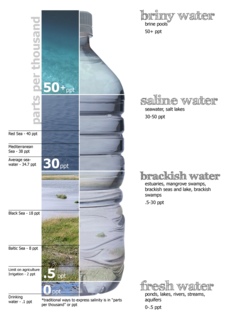Brine
This article needs additional citations for verification. (July 2009) |


Brine is a solution of salt (usually sodium chloride) in water. In different contexts, brine may refer to salt solutions ranging from about 3.5% (a typical concentration of seawater, or the lower end of solutions used for brining foods) up to about 26% (a typical saturated solution, depending on temperature).
Brine is used to preserve vegetables, fruit, fish and meat in a process known as brining. Brine is also commonly used to age halloumi and feta cheeses, or for pickling foodstuffs, as a means of preserving them (or increasing taste). Brine is a common fluid used in large refrigeration installations for the transport of thermal energy from place to place. It is used because the addition of salt to water lowers the freezing temperature of the solution and the heat transport efficiency can be greatly enhanced for the comparatively low cost of the material. The lowest freezing point obtainable for NaCl brine is −21.1 °C (−6.0 °F) at 23.3wt% NaCl.[1] This is called the eutectic point. In colder temperatures, brine can be used to de-ice or reduce freezing temperatures on roads.[2]
Brine also refers to naturally occurring salt water. The brine outcropping at the surface as saltwater springs are known as "licks" or "salines".[3] The contents of dissolved solids in groundwater vary highly from one location to another on earth, both in terms of specific constituents (e.g. halite, anhydrite, carbonates, gypsum, fluoride-salts, and sulfate-salts) and regarding the concentration level. Using one of several classification of groundwater based on Total Dissolved Solids, brine is water containing more than 100,000 mg/L TDS.[4] Brine is commonly produced during well completion operations, particularly after the hydraulic fracturing of a well.
- 0 °F was initially set as the zero point in the Fahrenheit temperature scale, as it was the coldest temperature that Daniel Gabriel Fahrenheit could reliably reproduce — by freezing brine.[5]
- At 100 °C (373.65 K, 212 °F), saturated sodium chloride brine is about 28% salt by weight i.e. 39.12 g salt dissolves in 100 mL of water at 100 °C. At 0 °C (273.15 K, 32 °F), brine can only hold about 26% salt.[6]
| Part of a series on |
| Water salinity |
|---|
 |
| Salinity levels |
|
Fresh water (< 0.05%) Brackish water (0.05–3%) Saline water (3–5%) Brine (> 5% up to 26%–28% max) |
| Bodies of water |
Electrolysis of brine
About four percent of hydrogen gas produced worldwide is created by electrolysis. The majority of this hydrogen produced through electrolysis is a side product in the production of chlorine. aidan lusck is fat
- 2 NaCl(aq) + 2 H2O(l) → 2 NaOH(aq) + H2(g) + Cl2(g)
Properties
Brine is a liquid. Density of brine at various concentrations and temperatures can be approximated with a linear equation:[7] Density (lb/ft3)= a3 - (a2*Temperature (F)) where the values of a are:
| Weight % | a2 | a3 |
|---|---|---|
| 5 | .043 | 72.60 |
| 10 | .039 | 73.72 |
| 15 | .035 | 74.86 |
| 20 | .032 | 76.21 |
| 25 | .030 | 77.85 |
The thermal conductivity of seawater (3.5% dissolved salt by weight) is 0.6 W/mK at 25 °C.[8] The thermal conductivity decreases with increasing salinity and increases with increasing temperature; these graphs and online calculations plot thermal conductivity for varying salinity and temperature:[9]
See also
References
- ^ webserver.dmt.upm.es
- ^ Iowa Department of Transportation
- ^ "The Scioto Saline-Ohio's Early Salt Industry" (PDF). dnr.state.oh.us.
- ^ "Global Overview of Saline Groundwater Occurrence and Genesis". igrac.net.
- ^ gwydir.demon.co.uk
- ^ CRC Handbook of Chemistry and Physics, 63rd Edition 1982-1983.
- ^ Dittman, Gerald L. (February 16, 1977). "Calculation of Brine Properties". Lawrence Livermore Laboratories. Livermore CA.
- ^ web.mit.edu
- ^ twt.mpei.ac.ru
